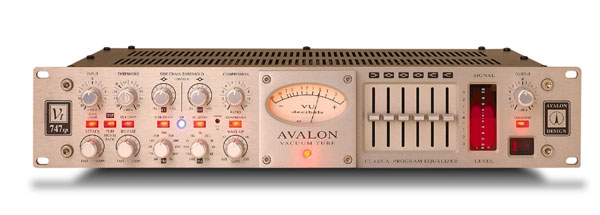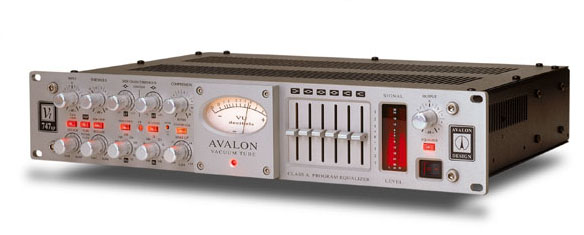|
AVALON DESIGN

Vt-747sp
Stereo Compressor and Equalizer
| By
John Krogh for MusicPlayer.com - All Rights Reserved 11/30/00
|
|
For many of us, the heart of our home studio centers around a
computer equipped with multitrack digital audio software and hardware.
These digital audio workstations (DAWs) can be powerful tools
for recording musicians, but critics have always leveled complaints
about DAWs sounding too "brittle" or "cold"
- lacking the kind of warmth that pro analog outboard gear, specifically
class A transistor and tube signal devices, provides.
|
It's no surprise, then, that there's been an overwhelming number
of processors (both hardware and software) for achieving the "sound"
of analog signal processors.
That's the thinking behind Avalon's Vt-747sp stereo compressor.
More than just a simple compressor, the 747 combines a six-band
graphic EQ and more, making it an ideal candidate for musicians
looking to tailor and sweeten their digital audio tracks.
|
|
OVERVIEW
Judging from its appearance alone you'd expect the Vt-747sp to
be an all around class act, and it is. Its case is made of steel,
and its gorgeous faceplate is made of solid brushed aluminum,
a common theme among all of Avalon's gear. The 747's knobs, switches,
and sliders all have a sturdy feel to them.
|
 |
Starting on the left, you'll find a single knob for input, and beneath
it a switch for boosting the input signal by 10dB. This switch lets
you drive the electronics harder to apply more of the unit's "sound."
Even though the 747 doesn't include a microphone preamp, this application
is what many engineers and musicians use vintage and high-end mic pres
for in a digital audio recording environment.
For DAW users, probably the most appealing aspect of the Vt-747sp is
its twin signal path design (TSP), which lets you choose between a class-A
transistor or tube output amplifier. If you want the warmth of a tube
signal path, you can have it with one press of a button. This is a great
option, and one that you're not likely to find on most outboard - it's
either tube or solid state.
The 747's compressor offers all of the controls you'd expect: compression
ratio, threshold, makeup gain, attack, and release. Unlike many compressors,
though, the 747 lacks a physical sidechain input, which could be used
for de-esssing and other frequency-specific compression applications.
Instead, low and high frequency parametric EQ controls can be used to
specify the frequency range(s) that the compressor reacts most strongly
to. You can monitor the frequencies being emphasized with the internal
sidechain EQ controls by engaging the SC Listen button. This proved
very useful for fine-tuning the compressor's response, especially when
I was dealing with a particularly sibilant vocal.
You can tell when and how quickly or slowly the compressor is clamping
down/releasing a signal by the small blue Gain Reduction Contour light.
I liked having the extra visual feedback that the contour light provides,
and its color set it apart from the other buttons (which light up red
when engaged), making it easy to see what the compressor was doing from
across the control room.
A single large VU meter is located in the center for gain reduction.
Since the 747 is a true stereo processor, and can't be split for dual
mono operation, one meter is all that's needed. But the output level
meters on the far right show you the levels for both left and right
sides, which is helpful for checking stereo balance.
Over on the right is the six-band passive graphic EQ. Shelving filters
are used for the 15Hz, 5kHz, and 32kHz frequency bands, while peak filters
are used for the 125Hz, 500Hz, and 2kHz bands. This section gives you
more sonic shaping control than any other of the 747's features. The
EQ is, as they say, very "musical sounding" ? smooth and pleasing,
with the kind of control you'd want for massaging final mixes. Of course,
its great for tracking individual parts as well. And the cherry on top:
The EQ can be placed before or after the compressor, which makes the
747 even more flexible.

|
IN USE
The Vt-747sp was a joy to work with. I used it on a variety of
projects for recording and mix down. Even though it's a stereo
unit, it worked great for tracking guitar, bass, and vocals. For
recording into my DAW, I preferred the 747's tube output amp,
which gave me a wonderful rich, beefy sound. But when it came
to mixing, the solid state output was the way to go. Too much
high frequency detail, particularly the crispness of the percussion
loops and acoustic guitars, was lost when I used the tube output.
But don't think that this rounding off of the highs isn't a shortcoming
of the unit - it's a common characteristic of tube processors.
Recording keyboards seems to be a specialty of this box, and
here's why: Getting a hot enough signal from a synth without introducing
too much noise can be a challenge. The 747's compressor and boost
switch gave me all the gain I needed to hit the AD converters
of my computer's audio interface with plenty of signal without
bringing up the noise floor.
Here's another reason keyboard players will like the 747: Its
EQ section is perfect for making synth/sampled strings sound more
airy and natural. I only wished that the EQ faders were detent
at regular dB increments instead of being continuous above and
below the zero dB detent. This would make it easier to recreate
your favorite recording and mixing settings.
Most of the controls are clearly labeled, so I had no trouble
understanding how various sections of the 747 operated. The only
exception was the EQ section. Labels for each of the six frequency
bands aren't silk screened on the front. Not really a
|
big deal, though, since the manual does an excellent job of describing
all the functions, as well as provide setup tips for a variety
of applications. There's even an informative glossary for newbies
? nice touch.
It never took very long to dial in good settings for the compressor,
although it was sometimes a bit tricky keeping it from pumping.
The compressor sounded extremely transparent and smooth as butter.
For one mix I needed to bump up the low end a bit, so I tweaked
the sidechain EQ to make the compressor work harder on the low
end, without choking the highs. Normally I'd use a multi-band
compressor for this type of mixing trick, but the end result was
about the same using the Avalon's sidechain.
The only snag I ran into with the 747 is in getting it connected
into my studio. The 747 only uses balanced line-level XLR connectors,
which meant I had to find 1/4-inch to male and female XLR send/return
cables if I wanted to insert the compressor/EQ into the channels
on my Mackie 8-bus mixer. This type of cable wasn't stocked by
most of the pro-audio shops in my area, but I eventually found
a friend who happened to have the correct type of cables. If I
were to change
anything about the 747's I/O, I'd add 1/4-inch inputs for sure,
as well as digital I/O. Admittedly, this last item is a pie in
the sky wish, but not completely unrealistic. After all, several
high-end pro audio manufacturers, including Manley and TC Electronic,
offer boxes with digital I/O.
|
|
CONCLUSIONS
Avalon's Vt-747sp stereo compressor/EQ combines an attractive
feature set with stunning audio quality and a flexible design.
It's equally well suited for mastering and tracking stereo and
even mono sources. Each of its sections can be used individually,
which makes the 747 versatile for high-end project studios. Its
price tag might be daunting to some, but consider what you get:
|
a silky smooth compressor, tube or solid state output, the 10dB
input boost, and a great-sounding six-band EQ. That's a lot for
$2,495. While the market for audio processors aimed at giving
your tracks "analog vibe" is becoming saturated, Avalon's
Vt-747sp is in an elite class that few production tools can touch.
|
Back to Reviews Index & User List
|


